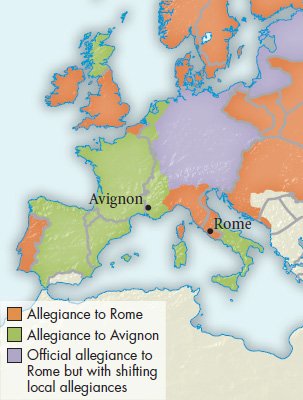The Babylonian Captivity and Great Schism
Conflicts between the secular rulers of Europe and the popes were common throughout the High Middle Ages, and in the early fourteenth century the dispute between King Philip the Fair of France and Pope Boniface VIII became particularly bitter. After Boniface’s death, in order to control the church and its policies, Philip pressured the new pope, Clement V, to settle permanently in Avignon in southeastern France. The popes lived in Avignon from 1309 to 1376, a period in church history often called the Babylonian Captivity (referring to the seventy years the ancient Hebrews were held captive in Mesopotamian Babylon).
The Babylonian Captivity badly damaged papal prestige. The seven popes at Avignon concentrated on bureaucratic and financial matters to the exclusion of spiritual objectives, and the general atmosphere was one of luxury and extravagance, which was also the case at many bishops’ courts. (See “Primary Source 11.3: Raimon de Cornet on the Avignon Papacy.”) The leadership of the church was cut off from its historic roots and the source of its ancient authority, the city of Rome. In 1377 Pope Gregory XI brought the papal court back to Rome but died shortly afterward. Roman citizens pressured the cardinals to elect an Italian, and they chose a distinguished administrator, the archbishop of Bari, Bartolomeo Prignano, who took the name Urban VI.

Urban VI (pontificate 1378–1389) had excellent intentions for church reform, but he went about it in a tactless manner. He attacked clerical luxury, denouncing individual cardinals and bishops by name, and even threatened to excommunicate some of them. The cardinals slipped away from Rome and met at Anagni. They declared Urban’s election invalid because it had come about under threats from the Roman mob, and excommunicated the pope. The cardinals then elected Cardinal Robert of Geneva, the cousin of King Charles V of France, as pope. Cardinal Robert took the name Clement VII. There were thus two popes in 1378 — Urban at Rome and Clement VII (pontificate 1378–1394) at Avignon. So began the Great Schism, which divided Western Christendom until 1417.
The powers of Europe aligned themselves with Urban or Clement along strictly political lines. France naturally recognized the French pope, Clement. England, France’s long-time enemy, recognized the Italian pope, Urban. Scotland, an ally of France, supported Clement. Aragon, Castile, and Portugal hesitated before deciding for Clement as well. The German emperor, hostile to France, recognized Urban. At first the Italian city-states recognized Urban; later they opted for Clement.
John of Spoleto, a professor at the law school at Bologna, eloquently summed up intellectual opinion of the schism: “The longer this schism lasts, the more it appears to be costing, and the more harm it does; scandal, massacres, ruination, agitations, troubles and disturbances.”7 The schism weakened the religious faith of many Christians and brought church leadership into serious disrepute.